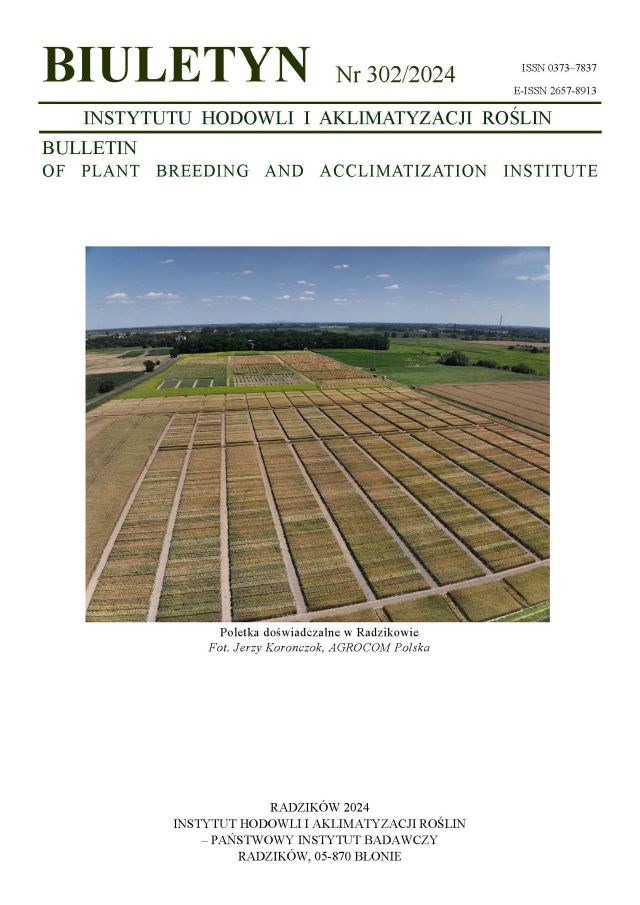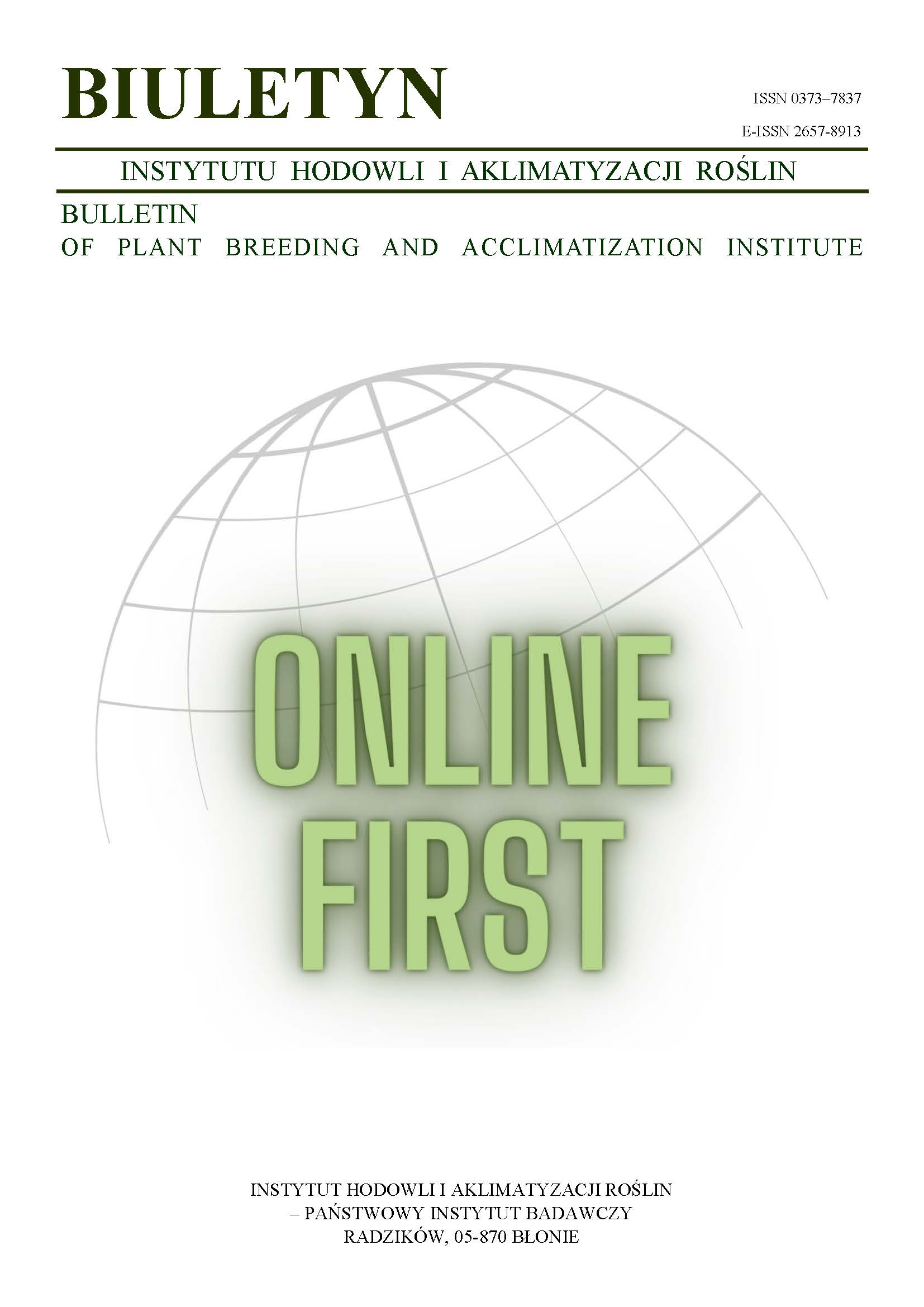A possibility to use zinc in protection of potatoes against early blight
Jerzy Osowski
j.osowski@ihar.edu.plZakład Nasiennictwa i Ochrony Ziemniaka w Boninie, Instytut Hodowli i Aklimatyzacji Roślin w Radzikowie (Poland)
Abstract
The efficacy of different leaf fertilizers in reducing the incidence of early blight in potato plants was compared in the field investigations carried out in the years 2003–2004 in Bonin. Six variants of plant protection were assessed. The best results were obtained with the following variants: (2x) Basfoliar 12-4-6, applied at a dose of 2.0 l/ha (rate of efficacy 86%), and half-dose chemical protection (Antracol 70 WG, Unikat 75 WG) + Basfoliar 12-4-6 (2 l/ha) (rate of efficacy 85.3%).
Keywords:
chemical control, dose reduction, early blight, leaf fertilization, zincReferences
Boligłowa E., Dzienia S. 1999. Impact of fertilization of plant on the content of macro elements in potato. EJPAU Vol. 2 Issue 2 series Agronomy.
Google Scholar
Broggio M., Ranucci A. 1991. A comparison of two infection methods for potato early blight (Alternaria solani Sorauer). Adv. Hort. Sci. 5: 18 — 22.
Google Scholar
Christ B. J. 1990. Influence of potato cultivars on the effectiveness of fungicide control of early blight. American Potato Journal, 67: 7: 419 — 425
DOI: https://doi.org/10.1007/BF03044510
Google Scholar
Dorożkin N. A., Ivanjuk V. G. 1979. Epifitotii rannoj suchoj pjatnistosti kartofelja i tomatov. Mikol. Fitopatol. 13, 4: 314 — 321.
Google Scholar
Fry W. E. 1978. Quantification of general resistance of potato cultivars and fungicide effects for integrated control of late blight. Phytopathology 68: 1650 — 1655.
DOI: https://doi.org/10.1094/Phyto-68-1650
Google Scholar
Johnson K. B., Teng P. S. 1990. Coupling a disease progress model for early blight to a model potato growth. Phytopathology 80: 4, 416 — 425.
DOI: https://doi.org/10.1094/Phyto-80-416
Google Scholar
Kapsa J. 2002. Możliwości ograniczania dawek fungicydów przez dodatek Insolu 7 w ochronie plantacji ziemniaka przed Phytophthora infestans (Mont.) de Bary. Mat. konf. „ Perspektywy rozwoju ochrony roślin w Polsce w XXI wieku”, Kraków 25–26.06. 2002, 81: 75 — 79.
Google Scholar
Osowski J. 2001. Potrzeba i możliwości zwalczania alternariozy. Ziemn. Polski, 2: 19 — 22.
Google Scholar
Pelletier J. R., Fry W. E. 1990. Characterization of resistance to early blight in three potato cultivars: receptivity. Ecology and Epidemiology 80: 4: 361 — 366.
DOI: https://doi.org/10.1094/Phyto-80-361
Google Scholar
Pietkiewicz J. B. 1972. Badanie odporności ziemniaków na zarazę ziemniaczaną (Phytophthora infestans de Bary) na odciętych liściach. Biul. Inst. Ziemn. 9: 17 — 32
Google Scholar
Pietkiewicz J. B. 1992. The use of leaf-applied fertilizers in late blight control. In: Agriculture and Environment in Eastern Europe and Netherlands. Proc. Agric. Univ. Wageningen: 241 — 245
Google Scholar
Pietkiewicz J. B., Kowański K., Lewosz W. 1988. Przydatność Florogamy 0 do zwalczania zarazy ziemniaka (Phytophthora infestans (Mont.) de Bary). Mat. XXVII Sesji Naukowej IOR. Cz. I Referaty. PWRiL, Poznań: 203 — 208.
Google Scholar
Stewart H. E., Bradshaw J. E. 1993. A glasshouse test for assessing resistance to early blight (Alternaria solani). Potato Research. 1993, 36/ 1: 35 — 42.
DOI: https://doi.org/10.1007/BF02359832
Google Scholar
Szukalski H. 1979. Mikroelementy w produkcji roślinnej. PWRiL, Warszawa: 178 — 205.
Google Scholar
Tucker M. R. 1999. Essential Plant Nutritions: their presence in North Carolina soils and role in plant nutrition. www.ncagr.com/agronomi/essential. htm.
Google Scholar
Wnękowski S. 1971. Alternarioza ziemniaków. Ochrona Roślin 9: 5 — 7.
Google Scholar
Authors
Jerzy Osowskij.osowski@ihar.edu.pl
Zakład Nasiennictwa i Ochrony Ziemniaka w Boninie, Instytut Hodowli i Aklimatyzacji Roślin w Radzikowie Poland
Statistics
Abstract views: 14PDF downloads: 6
License
Copyright (c) 2005 Jerzy Osowski

This work is licensed under a Creative Commons Attribution-ShareAlike 4.0 International License.
Upon submitting the article, the Authors grant the Publisher a non-exclusive and free license to use the article for an indefinite period of time throughout the world in the following fields of use:
- Production and reproduction of copies of the article using a specific technique, including printing and digital technology.
- Placing on the market, lending or renting the original or copies of the article.
- Public performance, exhibition, display, reproduction, broadcasting and re-broadcasting, as well as making the article publicly available in such a way that everyone can access it at a place and time of their choice.
- Including the article in a collective work.
- Uploading an article in electronic form to electronic platforms or otherwise introducing an article in electronic form to the Internet or other network.
- Dissemination of the article in electronic form on the Internet or other network, in collective work as well as independently.
- Making the article available in an electronic version in such a way that everyone can access it at a place and time of their choice, in particular via the Internet.
Authors by sending a request for publication:
- They consent to the publication of the article in the journal,
- They agree to give the publication a DOI (Digital Object Identifier),
- They undertake to comply with the publishing house's code of ethics in accordance with the guidelines of the Committee on Publication Ethics (COPE), (http://ihar.edu.pl/biblioteka_i_wydawnictwa.php),
- They consent to the articles being made available in electronic form under the CC BY-SA 4.0 license, in open access,
- They agree to send article metadata to commercial and non-commercial journal indexing databases.
Most read articles by the same author(s)
- Jerzy Osowski, Diversity of black scurf symptoms caused by Rhizoctonia solani on potato tubers depending on cultivar and meteorological conditions , Bulletin of Plant Breeding and Acclimatization Institute: No. 274 (2014): Regular issue
- Jerzy Osowski, Janusz Urbanowicz , Silver scab (Helminthosporium solani) – symptoms and control , Bulletin of Plant Breeding and Acclimatization Institute: No. 294 (2021): Regular issue
- Jerzy Osowski, Janusz Urbanowicz, The influence of microstarters B and K on the volume and quality of potato tubers , Bulletin of Plant Breeding and Acclimatization Institute: No. 292 (2020): Special issue
- Jerzy Osowski, Resistance of potato varieties as an element of integrated pest management , Bulletin of Plant Breeding and Acclimatization Institute: No. 266 (2012): Regular issue
- Edward Bernat, Jerzy Osowski, The use of decision support system NegFry to late blight control , Bulletin of Plant Breeding and Acclimatization Institute: No. 256 (2010): Regular issue
- Józefa Kapsa, Marek Mrówczyński, Tomasz Erlichowski, Hanna Gawińska-Urbanowicz, Konrad Matysek, Jerzy Osowski, Maria Pawińska, Janusz Urbanowicz, Sławomir Wróbel, Potato protection according to the principles of integrated pest management. Part II. Sustainable method of chemical potato protectio , Bulletin of Plant Breeding and Acclimatization Institute: No. 273 (2014): Regular issue
- Jerzy Osowski, Black dot (Colletotrichum coccodes) as a new threat to potato plantation , Bulletin of Plant Breeding and Acclimatization Institute: No. 251 (2009): Regular issue
- Jerzy Osowski, The rate of potato late blight development (Phytophthora infestans) in 2005–2007 depending on weather conditions and cultivar resistance , Bulletin of Plant Breeding and Acclimatization Institute: No. 255 (2010): Regular issue
- Józefa Kapsa, Marek Mrówczyński, Tomasz Erlichowski, Hanna Gawińska-Urbanowicz, Konrad Matysek, Jerzy Osowski, Maria Pawińska, Janusz Urbanowicz, Sławomir Wróbel, Potato protection according to the principles of integrated pest management. Part I. Non-chemical methods of protection , Bulletin of Plant Breeding and Acclimatization Institute: No. 273 (2014): Regular issue
- Jerzy Osowski, The effectiveness of some fungicides in reducing the mycelial growth of Alternaria solani and A. alternata under laboratory conditions , Bulletin of Plant Breeding and Acclimatization Institute: No. 243 (2007): Regular issue














